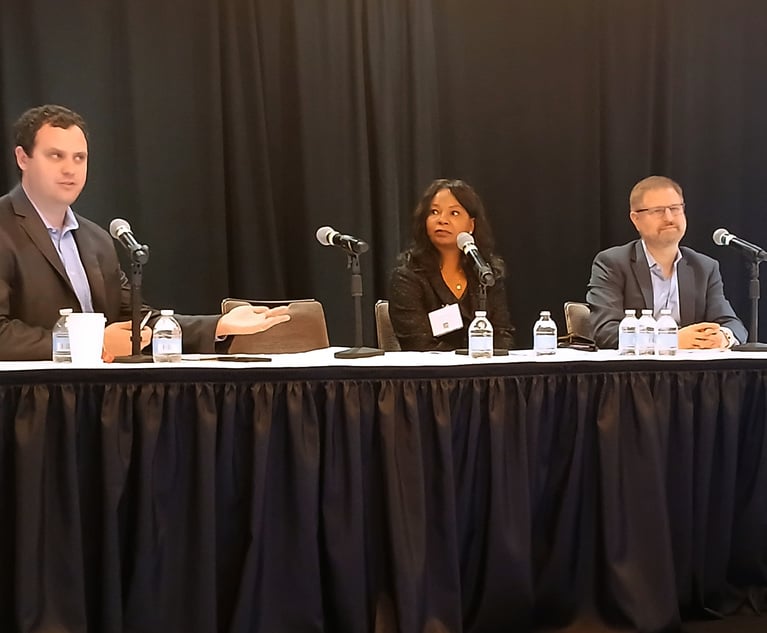LegalTech Highlights Legal Technology Trends
Every year outside counsel, in-house counsel and legal technologists and consultants undertake a massive pilgrimage to New York City for LegalTech.
February 08, 2008 at 07:34 AM
3 minute read
The original version of this story was published on Law.com
Every year outside counsel, in-house counsel and legal technologists and consultants undertake a massive pilgrimage to New York City for LegalTech. This year's event, which began Feb. 5, just wrapped up Feb. 7.
In case you're one of the uninitiated, LegalTech is like the Super Bowl of legal technology events. It's massive, taking up four floors of the Hilton New York Hotel in Midtown Manhattan. Hundreds of vendors fill every nook and cranny of floor space, promoting their products and services to the thousands of attendees.
LegalTech is the best place to spot the legal technology trends for the coming year. I had the privilege of speaking to dozens of vendors and professionals to find out firsthand what these trends are.
First, like last year, bringing the e-discovery process in house was still one of the most prominent developments. Vendors that for many years advertised their offerings solely to law firms are either shifting their marketing approach or are tweaking their products to get a piece of the in-house pie. For these companies, the sales pitch is pretty much the same across the board–general counsel want more control over the e-discovery process. And they're right. Large and small legal departments alike are looking at better ways to keep costs low and gain more transparency into the e-discovery process. As companies such as Verizon Communications Inc. have shown, the best way for them to do this is to take the responsibility of vendor selection out of the hands of outside counsel and bring it inside.
Another trend is the development of software that legal departments can use to ensure a defensible e-discovery process. A handful of vendors are diving into this area, possibly because established players have already spoken for the nuts-and-bolts of e-discovery, such as processing, review and production. These vendors are selling products that keep tabs on e-discovery workflow, creating logs of search terms and tracking custodian lists. When it's time to go to court, these programs can spit out documentation that provides transparency into the process, which counsel can then turn over to the opposition or a judge to prove the discovery's defensibility.
The last trend is an old one, but with a twist. Once again, legal departments will face increasing pressure from their internal clients to cut costs. But because of the expected downturn in the economy, in-house counsel can expect that pressure to go through the roof. In efforts to save money and track costs, e-billing and matter management solutions may become more of a necessity than ever. These vendors are anticipating this boost and have begun creating more advanced dashboards and visualizations to help counsel better understand where their money is going. In addition, early case assessment tools will become increasingly important allowing litigators to make the call early on whether its more cost-effective to pursue a case or settle it.
This content has been archived. It is available through our partners, LexisNexis® and Bloomberg Law.
To view this content, please continue to their sites.
Not a Lexis Subscriber?
Subscribe Now
Not a Bloomberg Law Subscriber?
Subscribe Now
NOT FOR REPRINT
© 2024 ALM Global, LLC, All Rights Reserved. Request academic re-use from www.copyright.com. All other uses, submit a request to [email protected]. For more information visit Asset & Logo Licensing.
You Might Like
View All
Lawyers Drowning in Cases Are Embracing AI Fastest—and Say It's Yielding Better Outcomes for Clients

GC Conference Takeaways: Picking AI Vendors 'a Bit of a Crap Shoot,' Beware of Internal Investigation 'Scope Creep'
8 minute read
Why ACLU's New Legal Director Says It's a 'Good Time to Take the Reins'
Trending Stories
- 1The Key Moves in the Reshuffling German Legal Market as 2025 Dawns
- 2Social Media Celebrities Clash in $100M Lawsuit
- 3Federal Judge Sets 2026 Admiralty Bench Trial in Baltimore Bridge Collapse Litigation
- 4Trump Media Accuses Purchaser Rep of Extortion, Harassment After Merger
- 5Judge Slashes $2M in Punitive Damages in Sober-Living Harassment Case
Who Got The Work
Michael G. Bongiorno, Andrew Scott Dulberg and Elizabeth E. Driscoll from Wilmer Cutler Pickering Hale and Dorr have stepped in to represent Symbotic Inc., an A.I.-enabled technology platform that focuses on increasing supply chain efficiency, and other defendants in a pending shareholder derivative lawsuit. The case, filed Oct. 2 in Massachusetts District Court by the Brown Law Firm on behalf of Stephen Austen, accuses certain officers and directors of misleading investors in regard to Symbotic's potential for margin growth by failing to disclose that the company was not equipped to timely deploy its systems or manage expenses through project delays. The case, assigned to U.S. District Judge Nathaniel M. Gorton, is 1:24-cv-12522, Austen v. Cohen et al.
Who Got The Work
Edmund Polubinski and Marie Killmond of Davis Polk & Wardwell have entered appearances for data platform software development company MongoDB and other defendants in a pending shareholder derivative lawsuit. The action, filed Oct. 7 in New York Southern District Court by the Brown Law Firm, accuses the company's directors and/or officers of falsely expressing confidence in the company’s restructuring of its sales incentive plan and downplaying the severity of decreases in its upfront commitments. The case is 1:24-cv-07594, Roy v. Ittycheria et al.
Who Got The Work
Amy O. Bruchs and Kurt F. Ellison of Michael Best & Friedrich have entered appearances for Epic Systems Corp. in a pending employment discrimination lawsuit. The suit was filed Sept. 7 in Wisconsin Western District Court by Levine Eisberner LLC and Siri & Glimstad on behalf of a project manager who claims that he was wrongfully terminated after applying for a religious exemption to the defendant's COVID-19 vaccine mandate. The case, assigned to U.S. Magistrate Judge Anita Marie Boor, is 3:24-cv-00630, Secker, Nathan v. Epic Systems Corporation.
Who Got The Work
David X. Sullivan, Thomas J. Finn and Gregory A. Hall from McCarter & English have entered appearances for Sunrun Installation Services in a pending civil rights lawsuit. The complaint was filed Sept. 4 in Connecticut District Court by attorney Robert M. Berke on behalf of former employee George Edward Steins, who was arrested and charged with employing an unregistered home improvement salesperson. The complaint alleges that had Sunrun informed the Connecticut Department of Consumer Protection that the plaintiff's employment had ended in 2017 and that he no longer held Sunrun's home improvement contractor license, he would not have been hit with charges, which were dismissed in May 2024. The case, assigned to U.S. District Judge Jeffrey A. Meyer, is 3:24-cv-01423, Steins v. Sunrun, Inc. et al.
Who Got The Work
Greenberg Traurig shareholder Joshua L. Raskin has entered an appearance for boohoo.com UK Ltd. in a pending patent infringement lawsuit. The suit, filed Sept. 3 in Texas Eastern District Court by Rozier Hardt McDonough on behalf of Alto Dynamics, asserts five patents related to an online shopping platform. The case, assigned to U.S. District Judge Rodney Gilstrap, is 2:24-cv-00719, Alto Dynamics, LLC v. boohoo.com UK Limited.
Featured Firms
Law Offices of Gary Martin Hays & Associates, P.C.
(470) 294-1674
Law Offices of Mark E. Salomone
(857) 444-6468
Smith & Hassler
(713) 739-1250







